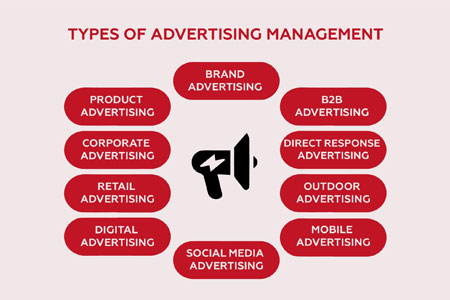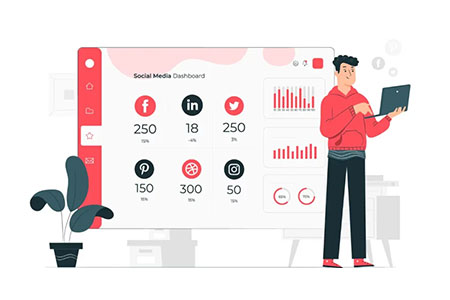Advertising Management: Meaning, Process, and Types

Introduction
A product might be excellent, but if no one knows it exists, it might as well not. In a world where people scroll, skip, and move on in seconds, grabbing attention is not just helpful. It is necessary. Advertising makes that possible, but not on its own. What really drives results is the system behind it. Advertising management turns scattered ideas into focused campaigns, helping brands stay in front and stay remembered.
Advertising management is the backbone of every successful brand campaign. It is not just about creating ads. It is about managing how, where, and when your message reaches your audience. For businesses today, especially in a highly competitive market, advertising management is not optional. It is a key part of the bigger marketing strategy. Without it, even the best products can go unnoticed.
This blog will walk you through what advertising management really means, why it matters, and how it is done right. Whether you run a small brand or lead marketing for a large company, this guide will help you understand the core of advertising management.
What is Advertising Management

Advertising management refers to the planning, execution, control, and analysis of advertising activities. It is the process of designing messages and selecting the right media to deliver those messages effectively. This section covers the advertising management definition in simple terms.
This involves working with creative teams, media planners, research analysts, and budgeting experts. It is not a one-time task. It is ongoing, evolving with market trends and consumer behavior.
The aim of advertising management is to make sure the brand’s message is not just heard, but remembered. A good advertising manager ensures that every campaign supports the overall business goals, whether it's growing awareness, launching a new product or driving sales.
What are the objectives of Advertising management
Advertising management is always goal-driven. Each campaign is crafted with specific results in mind. Let’s look at the key objectives.
Building Brand Awareness

The first step in any advertising strategy is letting people know that your brand exists. Through consistent messaging and visuals, advertising management helps your brand stay top of mind. Even if someone does not need your product today, they will remember it tomorrow when they do.
Influencing Consumer Behavior

Advertising is not just about showing a product. It is about shaping how people think and feel about it. A well-managed campaign encourages people to try something new, switch from a competitor, or even make impulse purchases.
Reinforcing Brand Recall

Even if your audience knows your brand, repeated exposure strengthens memory. Advertising management ensures regular, consistent messaging that helps consumers recall your brand when it matters most, right at the point of decision.
Types of Advertising Management

Different types of advertising management suit different goals, platforms, and target audiences.
Traditional Advertising
This includes print ads, billboards, television, and radio. Though older in format, traditional advertising still plays a strong role, especially for brands targeting mass markets or older demographics.
Digital Advertising
Digital advertising covers everything from search engine ads to display banners. It allows for precise targeting and performance tracking, making it a favorite among modern marketers.
Social Media Advertising
Platforms like Facebook, Instagram, and LinkedIn let brands interact with audiences directly. These ads are often interactive and come with detailed targeting options based on interests, behaviors, and location.
Influencer Marketing
Influencer marketing uses trusted personalities to promote products. It works because people trust people more than companies. A well-managed influencer campaign can build trust and generate immediate interest.
Mobile Advertising
As people spend more time on smartphones, mobile advertising has become crucial. This includes in-app advertising, push notifications, SMS marketing, and mobile-optimized banners. It offers real-time targeting and a personal touch.
Advertising Management Process

Managing advertising is a step-by-step process. The advertising management process includes planning, execution, and analysis. Each phase needs careful planning and teamwork.
Evaluate the Marketing Strategy
Before you even think about the ad, you must understand your business goals. What are you trying to achieve? Who is your audience? What message fits your brand tone? This evaluation shapes the rest of the advertising plan.
Develop an Advertising Blueprint
This is where ideas begin to take shape. The blueprint outlines the campaign’s objective, message, target audience, and media mix. It ensures everyone is on the same page before production starts.
Set the Budget
Budgeting is about balancing ambition with reality. You decide how much you can spend and allocate funds across platforms. A good advertising manager ensures the money is spent where it will create the most impact.
Select Media Platforms
Where will your ads appear? Choosing the right media is crucial. A flashy ad on the wrong platform will not work. Selection depends on your audience's habits. Young adults might be on Instagram, while older consumers watch TV or read newspapers.
Design Engaging Advertisements
This is the creative part. Teams work on visuals, copy, and calls to action. The design must reflect the brand’s personality and attract attention. Clarity, appeal, and simplicity matter the most here.
Launch the Advertising Campaign
Once the creatives are approved, the campaign goes live. This involves coordinating with media houses, publishing content, and monitoring real-time responses. Timing is key. A great campaign at the wrong moment might miss its mark.
Monitor and Assess Performance
After launching, you must track how the campaign performs. Are people clicking on the ads? Are sales going up? Analytics tools help measure what is working and what is not.
Refine and Adjust Strategies
Advertising is rarely perfect on the first try. Based on performance data, the campaign should be adjusted. Maybe the message needs more clarity. Or perhaps the media platform needs to change. Constant improvement is a part of advertising management.
Importance of Advertising Management

Why does advertising management matter so much? Because without it, even the best marketing ideas can fall apart. Here is why it is essential.
Introduces Your Brand to the Audience
No matter how great your product is, people will not buy it if they do not know about it. Advertising management ensures that your brand gets noticed in a crowded marketplace.
Maintains Control Over Advertising Efforts
A scattered campaign leads to confusion. Advertising management brings structure. It keeps messaging, design, and targeting aligned with business goals.
Boosts Sales
When done right, advertising creates demand. It guides consumers toward your product and encourages purchase. Advertising managers track and optimize campaigns to make sure they lead to actual sales.
Enables Precise Audience Targeting
Modern advertising tools allow brands to target specific groups based on behavior, geography, interests, and more. Advertising management ensures that your efforts reach the right people.
Offers Cost Efficiency
Without planning, advertising can quickly become expensive with little return. A managed approach ensures that every rupee spent brings value.
Provides Measurable Outcomes
With tools like Google Analytics, ad managers can measure the exact performance of each campaign. This helps in decision-making and future planning.
Facilitates Flexibility and Quick Adjustments
Markets change fast. Advertising management allows campaigns to pivot in real time. If a strategy is not working, it can be tweaked instantly to avoid losses.
Fosters Long-Term Customer Relationships
Good advertising is not about selling once. It is about building a lasting relationship. Advertising managers design campaigns that connect with customers emotionally, building trust and loyalty over time.
Challenges in Ad Management

Even with a clear process, managing advertising is not always easy. There are several challenges that brands must deal with.
One major challenge is the ever-changing digital landscape. Algorithms change, platforms evolve, and what worked last year may not work now. Staying up to date and adapting quickly is essential.
Budget constraints are another issue. Sometimes brands want big results with small budgets. While creativity can make a difference, limits on spending can restrict reach.
Audience fragmentation also makes things difficult. People consume content on different devices and platforms, often at the same time. Managing a campaign across all these touchpoints takes skill and coordination.
Lastly, measuring the true return on investment can be complex. While digital tools offer metrics, it is sometimes hard to link an ad directly to a sale, especially in long-term brand campaigns.
Conclusion
Advertising management is the engine behind effective brand communication. It helps businesses reach the right people, at the right time, with the right message. From setting goals and choosing platforms to designing creative ads and measuring results, each step plays a vital role in business growth.
As the advertising world grows more complex, smart management becomes even more important. Whether you are running traditional print campaigns or managing influencer partnerships online, a structured approach ensures better results.
If your business wants to make a mark through powerful advertising, Excellent Publicity can help. With deep expertise and a strong understanding of the market, we bring your brand vision to life—one smart campaign at a time.
FAQs
Start by setting clear goals like increasing sales or brand awareness. Then, look at how much money you can afford to spend. Divide your budget across channels that best reach your audience. Always leave room for testing and changes during the campaign.
Digital platforms like social media, search engines, and websites work well because they reach people fast. TV is good for wide reach. Print works best for local or older audiences. The right channel depends on your target group and goals.
Track how many people saw your ad, clicked on it, or bought something after. Use tools like Google Analytics or social media insights. Look at sales, website visits, or customer calls to see what is working and what needs to change.
Keep testing different messages, images, and channels. Listen to feedback and study what your audience reacts to. Use this to improve future ads. Stay updated on market trends so you can adjust your strategy when needed.
Creativity makes ads stand out and keeps people interested. A creative idea can grab attention and make your message easy to remember. It helps your brand feel fresh and keeps people coming back for more.



